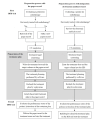Enhancing the Efficiency of a Radiation Oncology Department Using Electronic Medical Records: Protocol for Preparing Radiotherapy
- PMID: 38393753
- PMCID: PMC10924260
- DOI: 10.2196/51002
Enhancing the Efficiency of a Radiation Oncology Department Using Electronic Medical Records: Protocol for Preparing Radiotherapy
Abstract
Background: Electronic medical records (EMRs) streamline medical processes, improve quality control, and facilitate data sharing among hospital departments. They also reduce maintenance costs and storage space needed for paper records, while saving time and providing structured data for future research.
Objective: This study aimed to investigate whether the integration of the radiation oncology information system and the hospital information system enhances the efficiency of the department of radiation oncology.
Methods: We held multidisciplinary discussions among physicians, physicists, medical radiation technologists, nurses, and engineers. We integrated paper records from the radiation oncology department into the existing hospital information system within the hospital. A new electronic interface was designed. A comparison was made between the time taken to retrieve information from either the paper records or the EMRs for radiation preparation. A total of 30 cases were randomly allocated in both the old paper-based system and the new EMR system. The time spent was calculated manually at every step during the process, and we performed an independent 1-tailed t test to evaluate the difference between the 2 systems.
Results: Since the system was launched in August 2020, more than 1000 medical records have been entered into the system, and this figure continues to increase. The total time needed for the radiation preparation process was reduced from 286.8 minutes to 154.3 minutes (P<.001)-a reduction of 46.2%. There was no longer any need to arrange for a nurse to organize the radiotherapy paper records, saving a workload of 16 hours per month.
Conclusions: The implementation of the integrated EMR system has resulted in a significant reduction in the number of steps involved in radiotherapy preparation, as well as a decrease in the amount of time required for the process. The new EMR system has provided numerous benefits for the department, including a decrease in workload, a simplified workflow, and conserving more patient data within a confined space.
Keywords: Hospital Information System; efficiency; electronic medical records; protocol; radiation oncology.
©Hao-Shen Cheng, Weir-Chiang You, Ni-Wei Chen, Mu-Chih Hsieh, Che-Fu Tsai, Chia-Jing Ho, Chien-Chih Chen. Originally published in JMIR Research Protocols (https://www.researchprotocols.org), 23.02.2024.
Conflict of interest statement
Conflicts of Interest: None declared.
Figures



Similar articles
-
Implementing and integrating a clinically driven electronic medical record for radiation oncology in a large medical enterprise.Front Oncol. 2013 Apr 18;3:69. doi: 10.3389/fonc.2013.00069. eCollection 2013. Front Oncol. 2013. PMID: 23616946 Free PMC article.
-
Copy-Pasting in Patients' Electronic Medical Records (EMRs): Use Judiciously and With Caution.Cureus. 2023 Jun 15;15(6):e40486. doi: 10.7759/cureus.40486. eCollection 2023 Jun. Cureus. 2023. PMID: 37461761 Free PMC article. Review.
-
Organic generation of real-world real-time data for clinical evidence in radiation oncology.Int J Med Inform. 2020 Dec;144:104301. doi: 10.1016/j.ijmedinf.2020.104301. Epub 2020 Oct 14. Int J Med Inform. 2020. PMID: 33091831
-
[Standard technical specifications for methacholine chloride (Methacholine) bronchial challenge test (2023)].Zhonghua Jie He He Hu Xi Za Zhi. 2024 Feb 12;47(2):101-119. doi: 10.3760/cma.j.cn112147-20231019-00247. Zhonghua Jie He He Hu Xi Za Zhi. 2024. PMID: 38309959 Chinese.
-
[Patient-centered image and data management in radiation oncology].Strahlenther Onkol. 2009 Jan;185(1):1-7. doi: 10.1007/s00066-009-1857-3. Epub 2009 Feb 18. Strahlenther Onkol. 2009. PMID: 19224141 Review. German.
References
-
- Negro-Calduch E, Azzopardi-Muscat N, Krishnamurthy RS, Novillo-Ortiz D. Technological progress in electronic health record system optimization: systematic review of systematic literature reviews. Int J Med Inform. 2021;152:104507. doi: 10.1016/j.ijmedinf.2021.104507. https://linkinghub.elsevier.com/retrieve/pii/S1386-5056(21)00133-7 S1386-5056(21)00133-7 - DOI - PMC - PubMed
-
- Aguirre RR, Suarez O, Fuentes M, Sanchez-Gonzalez MA. Electronic health record implementation: a review of resources and tools. Cureus. 2019;11(9):e5649. doi: 10.7759/cureus.5649. https://europepmc.org/abstract/MED/31700751 - DOI - PMC - PubMed
-
- Bittner MI. Information technology in radiation oncology-a brave new world? Front Oncol. 2013;3:116. doi: 10.3389/fonc.2013.00116. https://europepmc.org/abstract/MED/23717815 - DOI - PMC - PubMed
-
- Huang WL, Liu WS, Chen CH, Chang YH, Chang RJ. Study of development of electronic medical records system in radiation oncology. Therapeut Radiol Oncol. 2015;22(3):221–230. https://www.airitilibrary.com/Article/Detail?DocID=1023988x-201509-20151...
LinkOut - more resources
Full Text Sources

